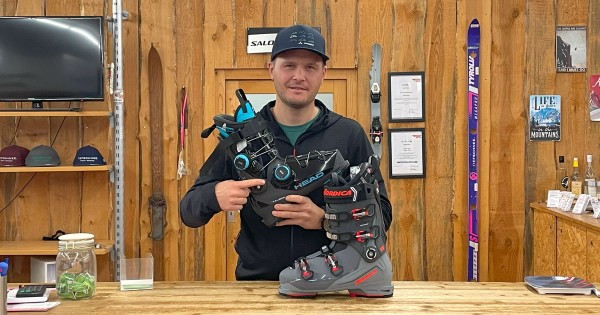Anyone looking to buy new ski boots will sooner or later be faced with the decision: Boa or classic buckles? Buckles have been a tried and tested fastening system for decades. The Boa system originated in snowboarding, but has also found its way into ski boots in recent years. But which is better and which system is right for you?
In this blog post, we take a closer look at the advantages and disadvantages, the differences and the areas of application of both systems. But let's get one thing straight from the outset: ultimately, it's your feet that decide which closure system is better for you.
What is the Boa system?
The exact name for the alpine boot Boa system is Boa H+i1. It consists of one or two finely adjustable knobs that tension a very sturdy steel wire. By simply turning the knob, the ski boot can be adjusted to fit your foot with millimetre precision.
Incidentally, the first ski boots with the Boa system were touring ski boots, e.g. from Atomic and Fischer. A lighter Boa system was used for these, but it was not suitable for alpine ski boots.
Buckle ski boots: The classic
We don't really need to explain buckle ski boots here, as everyone is familiar with them. They usually have three or four mechanical lever closures. The ski boot is closed by manually clicking/closing the ski boot and, if necessary, micro-adjusting the buckles. This system has been tried and tested for decades and is cheaper than the Boa system.
Why don't you see Boa ski boots in racing?
The ski and boot system is a very sensitive setup for top racers, which is only changed if another system is reliably better. Until such a system is fully developed, it is thoroughly tested and optimised. This is already happening quite successfully in racing and World Cup races. So we are (still) in the testing phase here.
Boa vs. buckle – a direct comparison
Boa: scores highly thanks to its fine adjustability. The Boa system closes very snugly around the foot, especially in the forefoot area, which can be very comfortable for feet with a high instep, for example. The Dual Dial Boa has an additional closure mechanism on the cuff, which allows you to better adjust the fit for narrow calves, for example.
Buckles: also offer good adjustment options, but not quite as fine as the Boa system. The tension is not distributed quite as evenly by the three or four buckles. However, this does not have to be a disadvantage, as each buckle can be adjusted separately. This can be particularly advantageous for feet with a flat instep.
Accessibility and comfort
Getting in and out is the same with both closure systems. The design of the ski boot is more decisive in this respect.
However, there are some differences in terms of general comfort.
Boa: When closing the ski boot, the Boa twist lock is easier to reach than the front buckle of the ski boot and, as described above, the Boa system closes more evenly around the foot, which can minimise pressure points.
Buckles: Here, more force is required in some places and you also need to be a little more flexible to close the front buckle. Pressure points can also occur if a buckle is closed too tightly.
Performance & control
Boa: There are models up to the sporty range with a flex of 130 or even 140. However, the Boa system is particularly appreciated in hybrid touring and also in the sport performance range.
Buckles: offer a tighter fit thanks to the individual closure of the buckles. If you ski aggressively, want 100% control and really let loose on the slopes, you should consider a buckle ski boot. Or upgrade a Boa ski boot with a ZIPFIT or foam liner, for example.
Durability and repair
Boa: the high-quality Boa H+i1 system is very robust. Even if you get caught on the stairs with the Boa wheel, you can almost always lock it back into the holder. If it does happen to break, repairs require special parts, which are available from any retailer that sells Boa ski boots – including us, of course.
Buckles: the simple mechanics of a buckle can often be repaired quickly and provisionally. If the buckles are screwed on rather than riveted, repairs are quick and inexpensive and can be carried out directly in the ski resort.
Weight
The Boa system tends to be lighter. This is particularly important for touring. In the field of alpine ski boots, the difference in weight is not significant. Here, the construction of the ski boot and the inner boot plays a greater role.
When is which closure system better?
Boa ski boots are ideal for:
• Recreational skiers who value comfort
• Skiers with sensitive feet, especially in the instep area
• Skiers who prefer easy operation
• Skiers who prefer a firm but not tight fit
Buckle ski boots are ideal for:
• Athletic racers who want a firm fit
• Skiers with rather narrow feet
• Price-conscious skiers
• Skiers with very individual fit requirements
Conclusion: As always, there is no general answer
Since our feet are very complex structures consisting of 26 bones, for example, it is impossible to give a general answer as to which closure system is better suited. Often, the shell shape, flex and inner boot of the ski boot are much more important than the closure system.
Our tip: Visit us at our shop in Lingen and try on both closure systems. Only then can you make the right choice.




